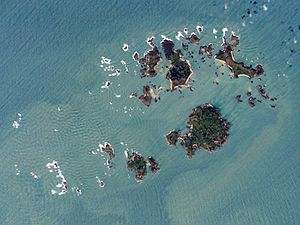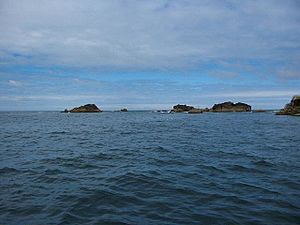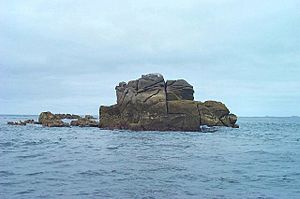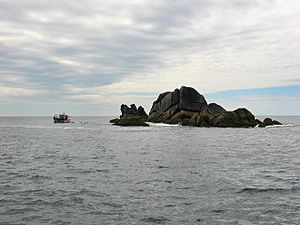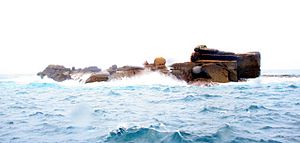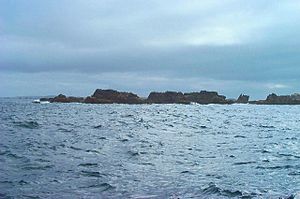Western Rocks, Isles of Scilly facts for kids
The Western Rocks (called Karregi Gorlewen in Cornish) are a group of small, uninhabited islands and rocks located in the southwestern part of the Isles of Scilly, United Kingdom. This area is famous for the many shipwrecks that have happened here and for the nearby Bishop Rock lighthouse. In 1971, these rocks and islands were officially named a Site of Special Scientific Interest (SSSI) because they are a very important breeding ground for sea birds. It's quite difficult and not recommended to land on these islands, so there aren't many records of people visiting them.
| Site of Special Scientific Interest | |
| Area of Search | Cornwall |
|---|---|
| Coordinates | 49°52′13″N 6°24′02″W / 49.8702°N 6.4006°W |
| Interest | Biological |
| Area | 62.7 hectares (0.627 km2; 0.242 sq mi) |
| Notification | 1971 |
Contents
A Special Place for Wildlife
The Western Rocks are mostly managed as nature reserves by the Isles of Scilly Wildlife Trust. This is mainly to protect the breeding seabirds and grey seals that live here.
Amazing Seabirds
There are eleven different kinds of seabirds that breed on these islands. Two of the most important are the European shag (a type of bird that dives for fish) and the European storm petrel (a small seabird that flies close to the water).
Other birds you might find breeding here include:
- Kittiwake (a type of gull)
- Razorbill (a black and white seabird)
- Guillemot (another diving seabird)
- Cormorant (a large, dark seabird)
- Fulmar (a seabird similar to a gull)
- Puffin (a colorful seabird with a large beak)
- Great black-backed gull (a very large gull)
- Lesser black-backed gull (a medium-sized gull)
- Herring gull (a common gull)
The Tiny Storm Petrels
The only places in England where European storm petrels breed are on the Isles of Scilly. There are eleven different groups of them, with about 1,475 breeding pairs. One island called Melledgan used to have the third-largest group, but now Roseveor has more, with 129 breeding pairs. Other islands in the Western Rocks where these special birds nest are Gorregan and Rosevean.
The Geography of the Rocks
All the Western Rocks are made of a type of rock called granite. This granite formed a very long time ago. The larger islands have thin, sandy soil. These islands are located southwest of St Mary's. Annet and St Agnes are just to the northeast, and the Bishop Rock lighthouse is to the west.
Main Islands and Rocks
The bigger islands in this group, from north to south, are:
- Great Crebwethan
- Rosevear
- Rosevean
- Daisy
- Pednathise Head (which is the most southerly point of the United Kingdom!)
Just to the west of these are Rosevear Ledge and the Gilstone Reef. Smaller islands and rocks in the Western Rocks include Codnors Rocks, Crebwethan, Jolly Rock, Jacky's Rock, Silver Carn, Gorregan, and Melledgan.
Exploring Individual Islands
Here are some details about a few of the islands and rocks in the Western Rocks. The sizes are measured at high tide by the Isles of Scilly Wildlife Trust.
Daisy
Daisy is about 0.57 hectares (1.4 acres) in size. It's a place where grey seals often come out of the water to rest.
Gilstone
The Gilstone, also known as Gilstone Reef or Gilstone Rock, is famous for causing many shipwrecks in the Isles of Scilly. The most well-known disaster was the sinking of Admiral Sir Cloudesley Shovell's ship, HMS Association, in the naval disaster of 1707. Over 1,400 lives were lost in that terrible event.
Gorregan
Gorregan (An Garregan in Cornish, meaning the rock place) is about 1.57 hectares (3.9 acres) in size and is 8 metres (26 ft) high. Its rocks are smooth and square, which is different from the "messy jumble" of rocks on other islands. Only a few plants grow here, like common scurvygrass and rock sea-spurry.
Gorregan is home to a breeding group of European storm petrels. It also has a large group of kittiwakes. Grey seals use Gorregan as a place to have their pups.
Great Crebawethan
Great Crebawethan (Krib an Wedhen in Cornish, meaning reef of the tree) is about 0.51 hectares (1.3 acres) in size. When scientists checked for European storm petrels here, they didn't find any.
Hellweathers
Hellweathers (Hal Weres in Cornish, meaning marsh ground) is a group of rocks located south of Annet.
Little Crebawethan
Little Crebawethan is a small island, about 0.14 hectares (0.35 acres) in size.
Melledgan
Melledgan (Men Lojowen in Cornish, meaning plant or herb stone) is about 0.96 hectares (2.4 acres) in size. This island used to have the third-largest group of European storm petrels in England. Cormorants and shags also breed here. Melledgan is a very important place for grey seals to have their pups and to rest. The seals' droppings help certain plants grow, like tree mallow and common scurvygrass.
Retarrier Ledges
These ledges are located between Bishop Rock and Rosevean. They are known for a sad event in 1875 when the German ship SS Schiller hit them, causing the loss of 335 lives.
Rosevean
Rosevean (Ros Vian in Cornish, meaning little promontory) is about 0.63 hectares (1.6 acres) in area and is the highest of the Western Rocks, reaching 17 metres (56 ft). It's mostly bare rock with only a few plants. It's important for its breeding birds and as a resting spot for grey seals. Scientists found 37 breeding pairs of European storm petrels here.
Rosevear
Rosevear (Ros Veur in Cornish, meaning great promontory) is the largest of the Western Rocks, about 2.17 hectares (5.4 acres) in size, with a fairly flat top about 5 metres (16 ft) high. This island was used as a base camp in the early 1700s for a team trying to salvage items from the Association and other ships that sank in 1707. Later, in the 1840s and 1850s, workers lived here while building the Bishop Rock lighthouse.
Rosevear has now become the island with the third-largest group of European storm petrels in England. The group of shags on Rosevear and the other Western Rocks is also very important for the whole country.
Other Named Rocks and Reefs
- Inner Rags
- Jacky's Rock
- Old Bess
- Pednathise Head
- Rags
The Western Rocks Through History
Unlike other islands in the Scilly group, there's no sign that people ever lived permanently on the Western Rocks. The only time people stayed there was temporarily on Rosevear in the mid-1800s when the lighthouse was being built.
In the past, sailing was very difficult, especially in cloudy weather. Sailors often had to guess their speed and direction. They didn't fully understand the sea currents, which could push ships further north than expected. Also, before 1750, maps showed these rocks about ten miles further north than they actually were! Because of these challenges, it's not surprising that the Western Rocks have seen many shipwrecks throughout history.
Famous Shipwrecks
The Gilstone Reef, in particular, has caused many terrible maritime disasters. The most famous was the sinking of Admiral Sir Cloudesley Shovell's ship, HMS Association, in 1707, which led to the loss of over 1,400 lives.
Seventy-seven years later, in 1784, a mail ship called the Nancy hit the Gilstone. Some of the crew and passengers tried to escape in a small boat, but it crashed onto Rosevear, killing everyone on board. A total of 36 crew members, 12 passengers, and 1 prisoner drowned. Among them was a famous actress named Ann Cargill. She was buried on Rosevear with other victims. Later, she was reburied in the churchyard in Old Town on St Mary's.
In 1841, the captain of a paddle steamer called the SS Thames mistook the lighthouse on St Agnes for another lighthouse called Longships. He changed course to the north and crashed onto the Cribewidden Rocks. Out of 66 people on board, 62 lost their lives. The second-highest loss of life happened in 1875 when the German ship SS Schiller hit the Retarrier Ledges, with 335 lives lost. Her captain knew they were near the Bishop Light but didn't realize they were already among the dangerous Western Rocks.
Today, the sites of these various shipwrecks are popular places for both professional and amateur divers. They explore the wrecks to identify and record them.


